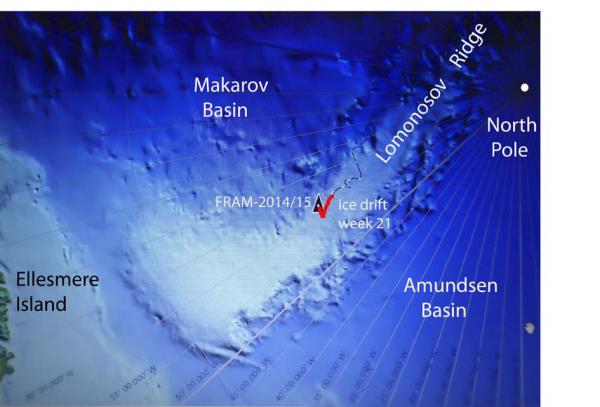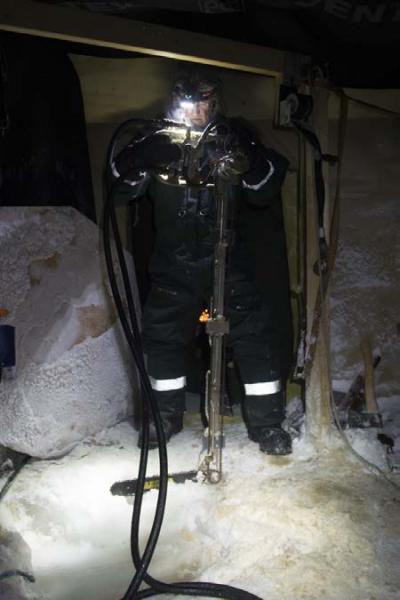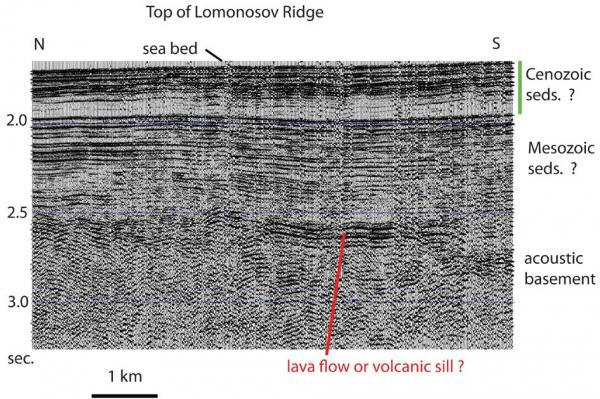
(19 - 26 Jan. 2015)
Ice drift
The ice camp moved only 21 nautical miles (39 km) during the week . The motion was southsoutheast along the top of Lomonosov Ridge on the Makarov Basin flank (Fig. 1). The major surface air pressure event of the week was a low moving up through the Fram Strait on Thursday, became centered at the North Pole and deepened on Friday and later moved onwards to Severnaya Zemlja. Winds were less than 16 knots. A more inconspicuous low pressure over the Canadian Arctic Islands generated winds over 20 knots and blowing snow from the afternoon of Sunday 25th. With that the ice drift changed 300 degrees and our camp was once again moving towards the Makarov Basin at a speed that increased to 0.6 knot.

Fig. 1. The drift track (red) of FRAM-2014/15 during week 21 (19-26 January, 2015).
Sea ice dynamics
This week, we have only heard a short event of ice ridging somewhere in the distance in the darkness.
Camp life
The week started with temperatures below -40° C on Monday. On Tuesday, the air got gradually warmer, the warmest being -29 on Thursday and then fell to -38° C on Sunday. Work this week has focused on how to compensate for the break-down of the two generators. First to change the heating system for the compressor, and then trying to get the smaller generator, the wind mill and the fuel cell up and running. The modifications of the heat box were finished on Thursday and tested on Friday. It became a better solution than what we had with electric heating; provides more heat and better service access. Audun worked on the small generator; the engine runs, but power is intermittent and the problem remains. He then turned to the fuel cell. The message he got from the display of a cell tested before departure was: Error code 75 - Call Service! The oracle at the company hot-line said; Press Reset three times - and then nothing more? The cell works for a short while and then quits. Next in line is the wind mill that was submerged by overwater on the ice and need to be taken apart before start-up.
The new moon came over the horizon on Friday, but has so far mostly been hidden by clouds. The total darkness have a considerable impact on your energy to get the daily work done - your constantly feeling tired even though the variety of food is good and you dutifully slip down a few vitamin pills and a mouthful of cod liver oil. You have to mobilize what you have of will power to keep on track with a regular daily schedule. Depending on the weather situation and ice activity, your work day in total darkness and priorities change constantly. Much of the work has to do with preparedness or compensate for not being prepared. Snow drifts grow and change constantly. To avoid loosing property in the snow may at times be a full time job for one person.
At the North Pole, the sun was 23° below the horizon on 22 December and it is at present about 14° below during mid-day. The darkest day of the year in Longyearbyen, Svalbard (22 Dec.) when the sun is 11° below the horizon, will be equivalent to the light we will experience on February 10th.
Science
During the week, the following suite of continuous measurements has been operating:
Bathymetry and sub-bottom profiling:
- four active autonomous echo sounder buoys reporting to shore via Iridium
- continuous seismic reflection measurements ( from early Saturday)
Oceanography:
- two Aanderaa current meters at 800 and 1050 meter depth, respectively.
Atmosphere:
- measurement of incoming and outgoing radiation from the ice surface
- surface infrared skin temperature
- sun time
- Aanderaa weather station
With heat back on the compressor, the seismic data acquisition is up and going again. But first, we had to open the refrozen hydro hole which was closed by a 0.5 m thick ice in the middle and narrowed on over the whole 1.5 m ice thickness along the edges. For this particular task we have constructed a hydraulic chain saw which is capable of making 1.2 m deep vertical cuts in the ice (Fig. 2). The saw performed very well and this was its first real test.

Fig. 2. The new hydraulic chain saw invented for making vertical cuts in the ice. This prototype made from junk yard resources works well.
The seismic results show another variety of what we consider acoustic basement on top of Lomonsov Ridge (Fig. 3). The sharp reflective segment and abrupt terminations are suggestive of a volcanic flow or a sill intrusion into the sediment pile. If so, it provides among other things a way to date the sediments as it may be related to the extensive volcanic activity that took place in the Eastern Arctic around 90 million years ago. Other occurrences of volcanics as interpreted from seismic data are known from the central part of Lomonosov Ridge and from the ridge plateau near Ellesmere Island.
We have retagged the kevlar rope at one hundred meter intervals as the original 3.000 m length has now been shortened to about 2.800 m due to wear. The intent is to take some short cores as we make the final crossing?? of the ridge on our return drift from the present excursion into the Makarov Basin. Strong persistent northeasterly winds from Sunday onwards are suddenly taking us one more time towards the Makarov Basin and maybe all the way across the postulated sheared continental margin of polar Europe in the late Mesozoic.

Fig. 3. Screen shot of seismic monitor to show possible presence of lava flow or volcanic sill as part of acoustic basement on top of Lomonosov Ridge. Some traces are noisy as the winds were 25-30 knots during acquisition.
In the absence of suitable generators, our temporary reduced capacity for charging of batteries, are a concern unless we run the main engine for extended time. One of the implications is insufficient power for the fan on the radiation flux instrument. We hope to find a solution in the coming week.
There has been no sign of animal life in our neighborhood during the week.
Life in the High Arctic is treating us well.
Yngve Kristoffersen & Audun Tholfsen
Daily reports
Monday 19 January.
Position: 87° 21.8' N, 63° 03' W, temperature below - 40° C, air pressure 1012 hPa, wind 5 knots from the W. Ice drift 0.1 knots towards E. A very cold day. A Zarges box is used as cabinet for the diesel stove and was attached to the compressor box. We run the main engine for fifteen every to thirty minutes two hours to charge the batteries.
Tuesday 20 January.
Position: 87° 21.6' N, 63° 00' W, temperature - 37° C, air pressure 1020 hPa, wind 3 knots from the SW. Ice drift 0.0 knots. Continued work on the compressor box. Moved the hydraulic oil tank to be included in the compressor box. Re-routed some of the air hoses. Tested the stove, but it would not burn properly.
Wednesday 21 January
Position: 87° 21.3' N, 62° 59' W, temperature - 33° C, air pressure 1021 hPa, wind 9 knot from the E. Ice drift 0.1 knots due east. Checked the radiation -flux instrument; cleaned sensors. Fan had stopped due to flat battery. Put in replacement battery. Audun downloaded data for the last month (since 19 Dec. 2014) from the memory card. The weather station is fine. Moved one fire extinguisher to the tent where the multi-fuel stove is going.
Thursday 22 January 2015
Position: 87° 20.5' N, 63° 04' W, temperature - 29° C, air pressure 1000 hPa, wind 11 knots. Ice drift 0.1 knot to the SSW. Finished the compressor heat box and started warming up. Audun worked on the small 800 W generator to see if we could get power from it - the engine runs, but power is sometimes there, but most often not.
Friday 23 January.
Position: 87° 13.4' N, 61° 38' W, temperature - 34° C, air pressure 1006 hPa, wind 10 knots from the NW. Ice drift 0.4 towards SE. The hydro hole had frozen up after not being used for 8 days. Had by now 0.5 m thick ice in the middle and the whole thickness along the sides. Mobilized the invented new hydraulic chain saw to make vertical cuts down-hole. This worked very well, but it still took most of the day to get the hole cleared.
Saturday 24 January
Position: 87° 08.6' N, 60° 17' W, temperature - 37° C, air pressure 1028 hPa, wind 6 knots from the NW. Ice drift 0.1 knot to the southeast. The air gun went into the water after midnight and seismic shooting resumed at 0253 hours. However, the seismic data logger started intermittent self trigging during the day. The problem was cured with advice from Ole Meyer. Audun started the fuel cell. Error code 75 Call service, was the response. Submitted an inquiry to the factory by e-mail.
Sunday 25 January.
Position: 87° 08.3' N, 60° 00' W, temperature -38° C, air pressure 1029 hPa, wind 3 knots from ESE. Ice drift 0.1 knots towards the south during the first part of the day. Shooting seismic reflaction all day. Prepared the winch and Kevlar drum. Started remarking the 2.800 m Kevlar we have left. The wind increased dramatically in the evening and the ice drift increased to 0.6 knot.

